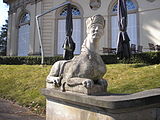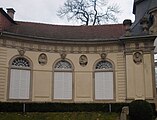Meuselwitz Orangery
The Orangerie Meuselwitz is a historic building in the rear part of the former palace grounds , now off-Seckendorf Park, in the city Meuselwitz in Altenburger Land in Thuringia .
Building description
The approximately 40-meter-long structure has a flat-arched floor plan and is closed at both ends by components that are slightly accentuated in height and protrude to the rear beyond the longitudinal structure and are each structured by four pilaster strips and a triangular gable. A total of 12 portrait busts of men and women with different facial expressions are mounted above and between the arched windows that extend to the floor in the three window axes between the central and the edge parts.
The jewelery rich central portion has bounded by four pilasters, an excessive glazed portal whose Supraporte is formed by a crest stone and framed by flower vases sculptures. The portal has a counterpart of the same size on the back. The middle part of the building ends in a curved and stepped baroque hood , which is crowned by a lantern with a vase.
In the middle part of the building there is a round pavilion. There are statues of the four seasons in the niches of the rotunda. From this central building the rooms go off on both wings.
The orangery is at the end of an axis in Von Seckendorff Park. Base stones, but still without statues, flank the path to the staircase leading to the central pavilion, which is lined with two sphinxes .
history
The orangery is the last remaining part of the palace complex, which was first built from a moated castle in the 16th century, came into the possession of the von Seckendorff family in 1676 and was rebuilt. Under Imperial Count Friedrich Heinrich von Seckendorff there were extensive expansions from 1724 to 1724. In this context, the baroque orangery was built in the palace park, which was built in the French-Dutch style as early as 1709 . The designs come from the Saxon state master builder David Schatz . The construction work was probably carried out by the Altenburg construction specialist Johann Georg Hellbrunn , who also carried out the palace extensions.
The palace and park including the orangery were visited by the upper class. The most prominent guests were August the Strong and King Friedrich Wilhelm I of Prussia. Suggest Bauähnlichkeiten that the Orangerie template for 1745 according to the plans of Frederick II. Formed the first stage of construction of Sanssouci Palace could have served.
During the bombing raid on Meuselwitz on March 20, 1945 , the orangery burned down and its dome collapsed in 1954. After that, security and reconstruction of the orangery began after the partially preserved castle had been completely torn down. In 1963 the interior was also expanded. In 1969 the orangery was reopened as a museum and concert hall. In the period that followed, decay set in again. In the 1980s, the building appeared to be in decline. After the emergency safety system, a comprehensive renovation of the entire structure was carried out between 1991 and 1998. Since then, the building with an attractive café / restaurant and a ballroom has been open to visitors for cultural and literary events.
The Meuselwitz Orangery and the surrounding park are included in the Wikipedia list of cultural monuments in Meuselwitz .
Impressions
Web links
- The orangery in the press
- The orangery on the city's website
- The orangery on geo.viaregia.org
- Historic photo
- Information on www.meinestadt.de
Individual evidence
Coordinates: 51 ° 2 ′ 45.7 ″ N , 12 ° 17 ′ 46.5 ″ E





